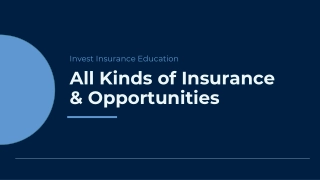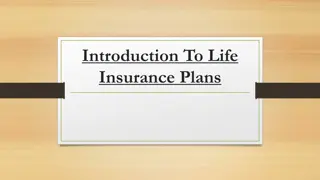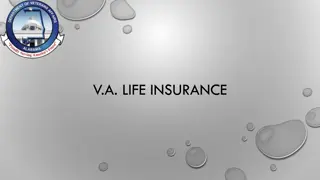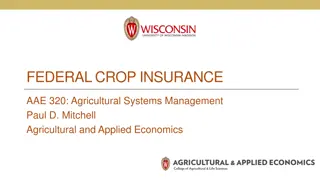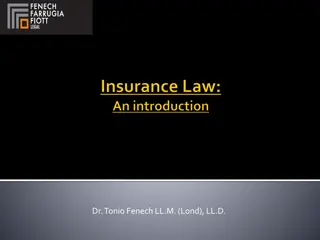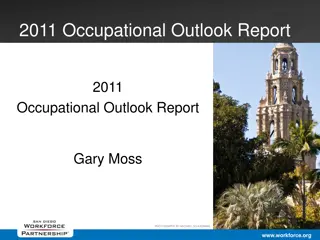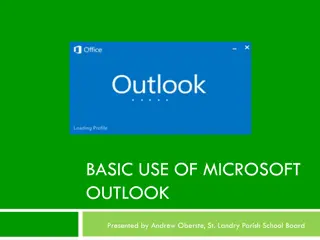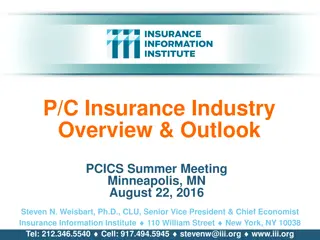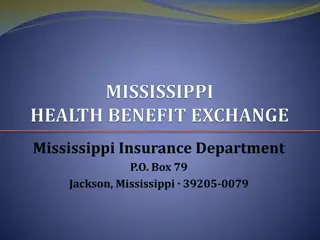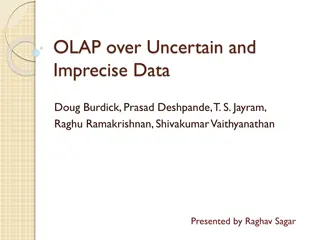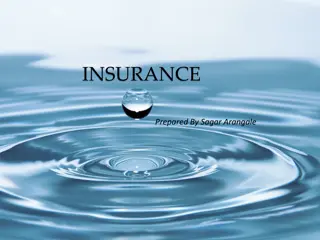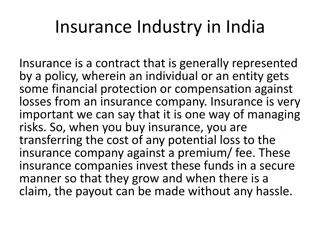Uncertain Times: Economic & Insurance Industry Outlook for 2014 and Beyond
Property Casualty Insurance Industry saw a rise in net income in 2013 compared to 2012 due to lower catastrophic events and increased capital gains. However, 2014 started slower. Profitability in the P/C Insurance Industry has experienced peaks and troughs over the years, with ROE history suggesting a peak in 2016-2017. Major events like Katrina, Rita, Wilma, and the financial crisis have influenced profitability. Combined ratios in the industry have improved from 2001 to 2014, reflecting a positive trend despite challenges like high catastrophic losses and a soft market.
Uploaded on Sep 19, 2024 | 4 Views
Download Presentation

Please find below an Image/Link to download the presentation.
The content on the website is provided AS IS for your information and personal use only. It may not be sold, licensed, or shared on other websites without obtaining consent from the author.If you encounter any issues during the download, it is possible that the publisher has removed the file from their server.
You are allowed to download the files provided on this website for personal or commercial use, subject to the condition that they are used lawfully. All files are the property of their respective owners.
The content on the website is provided AS IS for your information and personal use only. It may not be sold, licensed, or shared on other websites without obtaining consent from the author.
E N D
Presentation Transcript
U N C E R T A I N T I M E S : E C O N O M I C & I N S U R A N C E I N D U S T R Y O U T L O O K F O R 2 0 1 4 A N D B E Y O N D Robert P. Hartwig, Ph.D., CPCU President & Economist Insurance Information Institute AEGIS 2014 POLICYHOLDERS CONFERENCE POLICYHOLDERS CONFERENCE AEGIS 2014
Property Casualty Insurance Industry: Financial Update 2013 was a welcome respite from near-record catastrophe activity 2014: too soon to tell AEGIS 2014 POLICYHOLDERS CONFERENCE
P/C Industry Net Income after Taxes 1991 2014:Q1 $ Millions Net income rose strongly (+81.9%) in 2013 vs. 2012 on lower CATs, capital gains 2005 ROE*= 9.6% 2006 ROE = 12.7% 2007 ROE = 10.9% 2008 ROE = 0.1% 2009 ROE = 5.0% 2010 ROE = 6.6% 2011 ROAS1 = 3.5% 2012 ROAS1 = 5.9% 2013 ROAS1 = 10.3% 2014 ROAS1 = 8.4% $80,000 $65,777 $63,784 $62,496 $70,000 $60,000 $44,155 $38,501 $36,819 $50,000 $35,204 $33,522 $30,773 $30,029 $28,672 $40,000 $24,404 $21,865 $20,559 $20,598 $19,456 $19,316 $30,000 $14,178 $13,654 $10,870 $20,000 $5,840 $3,046 $3,043 2014 is off to a slower start $10,000 $0 -$10,000 -$6,970 14:Q1 96 00 04 08 12 91 92 93 94 95 97 98 99 01 02 03 05 06 07 09 10 11 13 ROE figures are GAAP; 1Return on avg. surplus. Excluding Mortgage & Financial Guaranty insurers yields an 8.2% ROAS through 2014:Q1, 9.8% ROAS in 2013, 6.2% ROAS in 2012, 4.7% ROAS for 2011, 7.6% for 2010 and 7.4% for 2009. Sources: A.M. Best, ISO; Insurance Information Institute AEGIS 2014 POLICYHOLDERS CONFERENCE
Profitability Peaks & Troughs in the P/C Insurance Industry 1975 2014:Q1* ROE History suggests next ROE peak will be in 2016-2017 1977: 19.0% 1987: 17.3% 25% 1997: 11.6% 2006: 12.7% 20% 2013 10.4% 15% 9 Years 10% 5% 2014:Q1 8.2% 0% 1975: 2.4% 1984: 1.8% 1992: 4.5% 2001: -1.2% -5% 79 06 75 76 77 78 80 81 82 83 84 85 86 87 88 89 90 91 92 93 94 95 96 97 98 99 00 01 02 03 04 05 07 08 09 10 11 12 13 14 *Profitability = P/C insurer ROEs. 2011-14 figures are estimates based on ROAS data. Note: Data for 2008-2014 exclude mortgage and financial guaranty insurers. Source: Insurance Information Institute; NAIC, ISO, A.M. Best. AEGIS 2014 POLICYHOLDERS CONFERENCE
ROE: Property / Casualty Insurance by Major Event 1987 2014:Q1 Percent P/C profitability is both by cyclicality and ordinary volatility 20% Katrina, Rita, Wilma 15% Low CATs 10% Sept. 11 5% Hugo Lowest CAT losses in 15 years Sandy 4 Hurricanes Andrew 0% Financial crisis* Record tornado losses Northridge -5% 87 88 89 90 91 92 93 94 95 96 97 98 99 00 01 02 03 04 05 06 07 08 09 10 11 12 13 14* * Excludes Mortgage & Financial Guarantee in 2008 2014. 2014 figure is through Q1:2014. Sources: ISO, Fortune; Insurance Information Institute. AEGIS 2014 POLICYHOLDERS CONFERENCE
P/C Insurance Industry Combined Ratio 2001 2014:Q1* As recently as 2001, insurers paid out nearly $1.16 for every $1 in earned premiums Higher CAT losses, shrinking reserve releases, toll of soft market Relatively low CAT losses, reserve releases Relatively low CAT losses, reserve releases 120 115.8 Heavy use of reinsurance lowered net losses Avg. CAT losses, more reserve releases Sandy impacts Cyclical deterioration Best combined ratio since 1949 (87.6) 110 107.5 106.3 Lower CAT losses 102.4 101.0 100.8 100.8 100.1 99.3 100 98.4 97.4 96.7 95.7 92.6 90 2001 2002 2003 2004 2005 2006 2007 2008 2009 2010 2011 2012 2013 2014 * Excludes Mortgage & Financial Guaranty insurers 2008--2012. Including M&FG, 2008=105.1, 2009=100.7, 2010=102.4, 2011=108.1; 2012:=103.2; 2013: = 96.1; 2014:Q1 = 97.3. Sources: A.M. Best, ISO. AEGIS 2014 POLICYHOLDERS CONFERENCE
A 100 Combined Ratio Isnt What It Once Was Investment impact on ROEs Combined Ratio / ROE A combined ratio of about 100 generates an ROE of ~7.0% in 2012/13, ~7.5% ROE in 2009/10, 10% in 2005 and 16% in 1979 110 20% 106.5 15.9% 105 14.3% 15% 102.4 12.7% 101.2 101.0 100.8 100.6 100.1 99.5 10.9% 100 96.7 9.6% 97.5 97.4 8.8% 10% 7.9% 95.7 7.4% 95 9.8% 6.2% 92.7 8.2% 4.7% 4.3% 5% 90 Lower CATs helped ROEs in 2013 85 0% 1978 1979 2003 2005 2006 2007 Combined Ratio 2008 2009 ROE* 2010 2011 2012 2013 2014:Q1 Combined ratios must be lower in today s depressed investment environment to generate risk appropriate ROEs * 2008 -2014 figures are return on average surplus and exclude mortgage and financial guaranty insurers. 2014:Q1 combined ratio including M&FG insurers is 97.3; 2013 = 96.1; 2012 =103.2, 2011 = 108.1, ROAS = 3.5%. Source: Insurance Information Institute from A.M. Best and ISO Verisk Analytics data. AEGIS 2014 POLICYHOLDERS CONFERENCE
Net Premium Growth: Annual Change 1971 2014:Q1 Percent 25% 1975-78 1984-87 2000-03 Net written premiums fell 0.7% in 2007 (first decline since 1943) by 2.0% in 2008, and 4.2% in 2009, the first 3-year decline since 1930-33. 20% 15% 2014:Q1: 3.6% 2013: 2012: 4.6% +4.3% 10% 5% 0% -5% 72 95 71 73 74 75 76 77 78 79 80 81 82 83 84 85 86 87 88 89 90 91 92 93 94 96 97 98 99 00 01 02 03 04 05 06 07 08 09 10 11 12 13 14 Shaded areas denote hard market periods Sources: A.M. Best (historical and forecast), ISO, Insurance Information Institute. AEGIS 2014 POLICYHOLDERS CONFERENCE
Average Commercial Rate Change, All Lines, 1Q:2004 1Q:2014 Percent Pricing as of Q1:2014 was positive for the 11th consecutive quarter 9% 5.2% 5.0% 4.4% 4.3% 4.3% 3.9% 3.4% 2.7% 2.1% 1.5% 4% 0.9% -0.1% -1% -0.1% -2.7% -2.9% -3.0% -3.2% -6% -4.6% -4.9% -5.1% -5.2% -5.3% -5.3% -5.4% -5.6% -5.8% -5.9% -6.4% -6.4% -7.0% -8.2% -9.4% -11% -9.6% -9.7% -11.0% -11.3% -11.8% -12.0% Q2 2011 marked the last of 30th consecutive quarter of price declines -12.9% -13.3% -13.5% -16% KRW effect 3Q04 2Q10 1Q04 2Q04 4Q04 1Q05 2Q05 3Q05 4Q05 1Q06 2Q06 3Q06 4Q06 1Q07 2Q07 3Q07 4Q07 1Q08 2Q08 3Q08 4Q08 1Q09 2Q09 3Q09 4Q09 1Q10 3Q10 4Q10 1Q11 2Q11 3Q11 4Q11 1Q12 2Q12 3Q12 4Q12 1Q13 2Q13 3Q13 4Q13 1Q14 Note: CIAB data cited here are based on a survey. Rate changes earned by individual insurers can and do vary, potentially substantially. Source: Council of Insurance Agents & Brokers; Insurance Information Institute AEGIS 2014 POLICYHOLDERS CONFERENCE
Change in Commercial Rate Renewals, by Line 2014:Q1 Percentage Change (%) D&O increases are large than any other line, followed by EPL and Workers Comp 6.0% 5.2% 4.9% 5.0% 4.1% 4.0% 3.3% 3.0% 2.0% 1.7% 2.0% 1.5% 0.9% 0.7% 1.0% 0.0% 0.0% Commercial Property Business Interruption Surety General Liability Umbrella ConstructionCommercial Workers Comp EPL D&O Auto Major commercial lines renewed generally upward in Q4:2014 for the 11th consecutive quarter; D&O, employment practices and workers comp leading the way; lower cat losses and falling reinsurance prices have pressured property coverages lower; low interest rates still exert upward rate pressure Note: CIAB data cited here are based on a survey. Rate changes earned by individual insurers can and do vary, potentially substantially. Source: Council of Insurance Agents and Brokers; Insurance Information Institute. AEGIS 2014 POLICYHOLDERS CONFERENCE
Change in Commercial Rate Renewals, by Account Size 1999:Q4 2014:Q1 Percentage Change (%) Pricing turned positive in Q3:2011, the first increase in nearly 8 years; Q1:2014 renewals were up 1.5%; some insurers posted stronger numbers. Peak = 2001:Q4 +28.5% Pricing turned negative in early 2004 and remained that way for 7 years KRW : no lasting impact Trough = 2007:Q3 - 13.6% Note: CIAB data cited here are based on a survey. Rate changes earned by individual insurers can and do vary, potentially substantially. Source: Council of Insurance Agents and Brokers; Barclay s Capital; Insurance Information Institute. AEGIS 2014 POLICYHOLDERS CONFERENCE
Cumulative Quarterly Commercial Rate Changes, by Account Size 1999:Q4 2014:Q1 1999:Q4 = 100 Despite 11 consecutive quarters of gains (Q1:2014 = +1.5%), pricing today is where is was in mid-2001 (around 9/11), suggesting additional rate need going forward, esp. in light of record low interest rates Note: CIAB data cited here are based on a survey. Rate changes earned by individual insurers can and do vary, potentially substantially. Source: Council of Insurance Agents and Brokers; Barclay s Capital; Insurance Information Institute. AEGIS 2014 POLICYHOLDERS CONFERENCE
Policyholder Surplus 2006:Q4 2014:Q1 $ Billions 2007:Q3 Pre-crisis peak Drop due to near-record 2011 CAT losses $662.0 $653.3 $700 $624.4 $614.0 $607.7 $650 $586.9 $583.5 $567.8 $566.5 $570.7 $559.2 $559.1 $550.3 $600 $544.8 $540.7 $538.6 $530.5 $521.8 $517.9 $515.6 $512.8 $511.5 $505.0 $550 $496.6 $490.8 $487.1 $478.5 $463.0 $455.6 $500 $437.1 Surplus as of 3/31/14 stood at a record high $662.0B $450 $400 06:Q4 07:Q1 07:Q2 07:Q3 07:Q4 The industry now has $1 of surplus for every $0.73 of NPW, close to the strongest claims-paying status in its history 08:Q1 08:Q2 08:Q3 08:Q4 09:Q1 09:Q2 09:Q3 09:Q4 10:Q1 10:Q2 10:Q3 10:Q4 11:Q1 11:Q2 11:Q3 11:Q4 12:Q1 12:Q2 12:Q3 12:Q4 13:Q1 13:Q2 13:Q3 13:Q4 14:Q1 2010:Q1 data includes $22.5B of paid-in capital from a holding company parent for one insurer s investment in a non-insurance business The P/C insurance industry entered 2014 in very strong financial condition Sources: ISO, A.M .Best. AEGIS 2014 POLICYHOLDERS CONFERENCE
US Insurance Mergers and Acquisitions, P/C Sector 2002 2013 (1) $ Millions $40,000 M&A activity in the P/C sector remains below pre-crisis levels 90 $35,221 80 $35,000 70 $30,000 60 $25,000 $20,353 50 $20,000 40 $16,294 $13,615 $15,000 $12,458 30 $9,264 $10,000 20 $6,419 $4,397 $4,651 $5,000 3507.0 10 $486 $425 $0 0 2002 2003 2004 2005 2006 2007 2008 2009 2010 2011 2012 2013 Transaction value Number of transactions (1) Includes transactions where a U.S. company was the acquirer and/or the target. Source: Conning proprietary database. AEGIS 2014 POLICYHOLDERS CONFERENCE
U.S. Insured Catastrophe Loss Update 2013 was a welcome respite from the high catastrophe losses in recent years but 2014 was the 5th costliest winter on record in the US AEGIS 2014 POLICYHOLDERS CONFERENCE
U.S. Insured Catastrophe Losses $ Billions, $ 2013 $74.5 2012 was the 3rd most expensive year ever for insured CAT losses $80 $70 $60 $50 $38.3 $35.5 $35.2 $34.2 $34.1 $40 $29.6 $26.8 $30 $16.5 $14.5 $14.2 $14.6 $12.9 $12.8 $11.7 $11.6 $20 $10.7 $11.1 $9.5 $8.9 $8.1 $7.7 $7.6 $6.2 $4.9 $3.8 $10 $0 89 90 91 92 93 94 95 96 97 98 99 2013 was a welcome respite from 2012, the 3rd costliest year for insured disaster losses in US history. Longer-term trend is for more not fewer costly events 0 1 2 3 4 5 6 7 $9.1 billion in insured CAT losses through June 30 8 9 10 11 12 13 14* *Through 6/30/14. Note: 2001 figure includes $20.3B for 9/11 losses reported through 12/31/01 ($25.9B 2011 dollars). Includes only business and personal property claims, business interruption and auto claims. Non-prop/BI losses = $12.2B ($15.6B in 2011 dollars.) Sources: Property Claims Service/ISO; Insurance Information Institute. AEGIS 2014 POLICYHOLDERS CONFERENCE
Combined Ratio Points Associated with Catastrophe Losses 1960 2013* Combined Ratio Points Catastrophe losses as a share of all losses reached a record high in 2012 10 Avg. CAT loss component of the combined ratio by decade 1960s: 1.04 1970s: 0.85 1980s: 1.31 8.9 8.8 8.7 8.1 8 1990s: 3.39 2000s: 3.52 2010s: 6.1E* 5.9 6 5.4 5 3.6 3.6 4 3.4 3.4 3.3 3.3 3.3 2.9 2.8 2.7 2.6 3 2.3 2.1 1.8 1.6 1.6 1.6 2 2 2 1.5 1.4 1.3 1.3 1.2 1.2 1.1 1.1 1.1 0.9 0.8 0.8 0.7 0.7 0.7 0.6 1 1 0.5 0.5 0.4 0.4 0.4 0.4 0.4 0.3 0.1 0 2013E 1960 1961 1962 1963 1964 1965 1966 1967 1968 1969 1970 1971 1972 1973 1974 1975 1976 1977 1978 1979 1980 1981 1982 1983 1984 1985 1986 1987 1988 1989 1990 1991 1992 1993 1994 1995 1996 1997 1998 1999 2000 2001 2002 2003 2004 2005 2006 2007 2008 2009 2010 2011 2012 The catastrophe loss component of private insurer losses has increased sharply in recent decades *2010s represent 2010-2013. Notes: Private carrier losses only. Excludes loss adjustment expenses and reinsurance reinstatement premiums. Figures are adjusted for losses ultimately paid by foreign insurers and reinsurers. Source: ISO (1960-2011); A.M. Best (2012E) Insurance Information Institute. AEGIS 2014 POLICYHOLDERS CONFERENCE
Top 16 Most Costly Disasters in US History, Insured Losses 2013 Dollars $ Billions Hurricane Sandy became the 5th costliest event in US insurance history $60 $49.4 $50 $40 Includes Tuscaloosa, AL, tornado Includes Joplin, MO, tornado $25.9 $24.9 $24.2 $30 $19.0 $13.6 $20 $11.2 $9.3 $8.8 $7.9 $7.6 $7.2 $6.8 $5.7 $5.6 $10 $4.5 $0 Irene (2011) Jeanne (2004) Frances (2004) Rita (2005) Tornadoes / T-Storms (2011) Tornadoes / T-Storms (2011) Hugo (1989) Ivan (2004) Charley (2004) Wilma (2005) Ike Sandy* (2012) Northridge (1994) 9/11 Attack (2001) Andrew (1992) Katrina (2005) (2008) Hurricane Irene became the 12th most expensive hurricane in US history in 2011 12 of the 16 most expensive events in US history have occurred over the past decade Sources: PCS; Insurance Information Institute inflation adjustments to 2013 dollars using the CPI. AEGIS 2014 POLICYHOLDERS CONFERENCE
Top 10 States for Insured Catastrophe Losses 2013 $ Millions $1,995 $2,000 Oklahoma led the country in insured CAT losses in 2013 due largely to severe tornado activity $1,600 $1,509 $1,190 $1,200 $909 $907 $805 $773 $762 $800 $677 $593 $400 $0 Oklahoma Texas Illinois Minnesota Colorado Mississippi Nebraska Georgia Indiana Louisiana Source: The Property Claim Services (PCS) unit of ISO, a Verisk Analytics company. AEGIS 2014 POLICYHOLDERS CONFERENCE
Top 5 States by Insured Catastrophe Losses in 2012* 2012 $ Billions $12,000 NY and NJ let the US in CAT losses in 2012 due Sandy $9,756 $10,000 $8,000 $6,369 $6,000 $4,000 $2,318 $2,000 $1,511 $1,440 $0 New York New Jersey Texas Kentucky Colorado *Includes catastrophe losses of at least $25 million. Sources: PCS unit of ISO; Insurance Information Institute. AEGIS 2014 POLICYHOLDERS CONFERENCE
Inflation Adjusted U.S. Catastrophe Losses by Cause of Loss 1994 20131 Fires (4), $5.5 Other (5), $0.2 Wind/Hail/Flood (3), $14.6 Insured cat losses from 1993-2012 totaled $386.7B, an average of $19.3B per year or $1.6B per month Geological Events, $18.4 3.8%1.4% 0.1% 4.8% Terrorism, $24.8 6.4% Winter Storms, $24.7 6.4% Hurricanes & Tropical Storms, $159.1 41.1% Tornado share of CAT losses is rising Events Involving Tornadoes (2), Wind losses are by far cause the most catastrophe losses, even if hurricanes / TS are excluded $139.3 36.0% 1. Catastrophes are defined as events causing direct insured losses to property of $25 million or more in 2013 dollars. 2. Excludes snow. 3. Does not include NFIP flood losses 4. Includes wildland fires 5. Includes civil disorders, water damage, utility disruptions and non-property losses such as those covered by workers compensation. Source: ISO s Property Claim Services Unit. AEGIS 2014 POLICYHOLDERS CONFERENCE
Natural Disasters in the United States 1980 2013 Number of Events (Annual Totals 1980 2013) 250 There were 128 natural disaster events in 2013 200 150 Number 100 22 19 50 81 6 1980 1982 1984 1986 1988 1990 1992 1994 1996 1998 2000 2002 2004 2006 2008 2010 2012 Geophysical (earthquake, tsunami, volcanic activity) Meteorological (storm) Hydrological (flood, mass movement) Climatological (temperature extremes, drought, wildfire) Source: MR NatCatSERVICE AEGIS 2014 POLICYHOLDERS CONFERENCE
Losses Due to Natural Disasters in the US 1980 2013 (Overall and Insured Losses) 2013 Dollars, $ Billions 200 2013 CAT losses Overall : $21.8B Insured: $12.8B 2013 losses were far below 2011 and 2012 and were 44% lower than the average from 2000-2012 Indicates a great deal of losses are uninsured (~40%-50% in the US) = growth opportunity 150 100 50 1980 1982 1984 1986 1988 1990 1992 1994 1996 1998 2000 2002 2004 2006 2008 2010 2012 Overall losses (in 2012 values) Insured losses (in 2013 values) Source: MR NatCatSERVICE AEGIS 2014 POLICYHOLDERS CONFERENCE
Natural Disaster Losses in the United States, by Type, 2013 Number of Events Estimated Overall Losses (US $m) Estimated Insured Losses (US $m) As of December 31, 2013 Fatalities Severe Thunderstorm 69 110 16,341 10,274 Winter Storm 11 43 2,935 1,895 Flood 19 23 1,929 240 Earthquake & Geophysical 6 1 Minor Minor Tropical Cyclone 1 1 Minor Minor Wildfire, Heat, & Drought 22 29 620 385 Totals 128 207 21,825 12,794 Source: Munich Re NatCatSERVICE AEGIS 2014 POLICYHOLDERS CONFERENCE
Top 16 Most Costly World Insurance Losses, 1970 2013* Insured Losses, 2013 Dollars $ Billions 2012 insured CAT losses totaled $60B; economic losses totaled $140B, according to Swiss Re 5 of the top 14 most expensive catastrophes in world history have occurred within the most recent 4 years (2010-2013) $60 $49.4 $50 $39.1 $40 Hurricane Sandy is now the 6th costliest event in global insurance history $30 $25.9 $24.9 $24.2 $19.0 $20 $13.6 $13.6 $13.6 $11.2 $9.7 $9.3 $8.8 $8.7 $10 $8.2 $7.9 $0 Hugo (1989) Winter Storm Daria (1991) Chile Quake (2010) Ivan (2004) Charley (2004) Typhoon Mirielle (1991) Wilma (2005) Thailand Floods (2011) New Zealand Quake (2011) Ike Sandy (2012) Northridge (1994) WTC Terror Attack (2001) Andrew (1992) Japan Quake, Tsunami (2011)** Katrina (2005) (2008) *Figures do not include federally insured flood losses. Sources: Munich Re; Swiss Re; Insurance Information Institute research. AEGIS 2014 POLICYHOLDERS CONFERENCE
Natural Loss Events Full year 2013 World Map Winter Storm Christian (St. Jude) Europe, 27 30 October Floods Europe, 30 May 19 June Meteorite impact Russian Federation, 15 February Flash floods Canada, 8 9 July Earthquake China, 20 April Floods Canada, 19 24 June Natural catastrophes Hailstorms Germany, 27 28 July Selection of significant Natural catastrophes Typhoon Fitow China, Japan, 5 9 October Floods USA, 9 16 September Severe storms, tornadoes USA, 18 22 May Geophysical events (earthquake, tsunami, volcanic activity) Typhoon Haiyan Philippines, 8 12 November Severe storms, tornadoes USA, 28 31 May Meteorological events (storm) Hydrological events (flood, mass movement) Floods Australia, 21 31 January Floods India, 14 30 June Hurricanes Ingrid & Manuel Mexico, 12 19 September Climatological events (extreme temperature, drought, wildfire) 880 Loss events Extraterrestrial events (Meteorite impact) Heat wave India, April June Earthquake (series) Pakistan, 24 28 September Source: Munich Re Geo Risks Research, NatCatSERVICE as of January 2014. Meteorological events (storm) AEGIS 2014 POLICYHOLDERS CONFERENCE
Natural Disasters Worldwide 1980 2013 Number of Events 1 000 There were 880 natural disaster events globally in 2013 compared to 905 in 2012 800 600 Number 400 200 1980 1982 1984 1986 1988 1990 1992 1994 1996 1998 2000 2002 2004 2006 2008 2010 2012 Geophysical (earthquake, tsunami, volcanic activity) Meteorological (storm) Hydrological (flood, mass movement) Climatological (temperature extremes, drought, wildfire) Source: MR NatCatSERVICE AEGIS 2014 POLICYHOLDERS CONFERENCE
Losses Due to Natural Disasters Worldwide 1980 2013 (Overall and Insured Losses) 2013 Dollars, $ Billions US$ bn 400 10-Yr. avg. losses Overall: $184B Insured: 2013 losses Overall: $125B Insured: $34B $56B 300 There is a clear upward trend in both insured and overall losses over the past 30+ years 200 100 1980 1982 1984 1986 1988 1990 1992 1994 1996 1998 2000 2002 2004 2006 2008 2010 2012 Overall losses (in 2012 values) Insured losses (in 2013 values) Source: MR NatCatSERVICE AEGIS 2014 POLICYHOLDERS CONFERENCE
US Thunderstorm Insured Loss Trends 1980 2013 Hurricanes get all the headlines, but thunderstorms are consistent producers of large scale loss. 2008-2013 are the most expensive years on record. Average thunderstorm losses are up 7 fold since the early 1980s. The 5- year running average loss is up sharply Thunderstorm losses in 2013 totaled $10.3 billion, the 6th highest on record Source: Property Claims Service, and MR NatCatSERVICE AEGIS 2014 POLICYHOLDERS CONFERENCE
Convective Loss Events in the US 1980 2013 Number of Events 140 The frequency of convective events has rising tremendously over the past 30+ years Convective events are those caused by straight- line winds, tornadoes, hail, heavy precipitation, flash floods and lightning 120 100 80 60 40 20 1980 1982 1984 1986 1988 1990 1992 1994 1996 1998 2000 2002 2004 2006 2008 2010 2012 Source: Geo Risks Research, NatCatSERVICE. AEGIS 2014 POLICYHOLDERS CONFERENCE
Convective Loss Events in the US 1980 2012 and first half 2013 (overall and insured losses) $ Billions US 50 The insured and total economic cost of convective events has rising tremendously over the past 30+ years Convective events are those caused by straight-line winds, tornadoes, hail, heavy precipitation, flash floods and lightning 40 30 20 10 1980 1982 1984 1986 1988 1990 1992 1994 1996 1998 2000 2002 2004 2006 2008 2010 2012 Overall losses (in 2012 values) Insured losses (in 2013 values) Analysis contains: straight-line winds, tornadoes, hail, heavy precipitation, flash floods, lightning. Source: Geo Risks Research, NatCatSERVICE. AEGIS 2014 POLICYHOLDERS CONFERENCE
Insured Homeowners Losses Due to Lightning 2004 2013 $ Millions $1,100 $1,065.5 $1,033.5 $1,000 $969.0 $952.5 $942.4 $882.2 $900 $819.6 $798.0 $800 $735.5 $700 $673.5 Lightning claims cost insurers an estimated $673.5 million in 2013, down from previous years as drought and fewer convective events reduced strikes $600 $500 2004 2005 2006 2007 2008 2009 2010 2011 2012 2013 The increased number and value of expensive electronic devices in homes has pushed total lightning claim costs to about $1 billion in many years even as the number of lightning claims falls Source: Insurance Information Institute. AEGIS 2014 POLICYHOLDERS CONFERENCE
Outlook for the 2014 Atlantic Hurricane Season Hurricanes and tropical storms drive some of the largest losses utilities expect each year AEGIS 2014 POLICYHOLDERS CONFERENCE
Top 12 Most Costly Hurricanes in US History Insured losses, 2013 dollars $ Billions 10 of the 12 most costly hurricanes in insurance history occurred over the past 10 years (2004 2013) $60 $49.4 $50 Hurricane Sandy is the 3rd costliest hurricane in US insurance history $40 $30 $25.9 $19.0 $20 $13.6 $11.2 $9.3 $8.8 $10 $7.9 $6.8 $5.7 $5.6 $4.5 $0 Irene (2011) Jeanne (2004) Frances (2004) Rita (2005) Hugo (1989) Ivan (2004) Charley (2004) Wilma (2005) Ike Sandy (2012) Andrew (1992) Katrina (2005) (2008) Sources: PCS; Insurance Information Institute inflation adjustments to 2013 dollars using the CPI. AEGIS 2014 POLICYHOLDERS CONFERENCE
Outlook for 2014 Hurricane Season 30% less active than typical year 2005 Median* 12.0 (Katrina Year) 28 2014F 10 Named Storms Named Storm Days 60.1 115.5 40 Hurricanes 6.5 14 4 Hurricane Days 21.3 47.5 15 Major Hurricanes 2.0 7 1 Major Hurricane Days 3.9 7 3 Accumulated Cyclone Energy 92.0 NA 65 Net Tropical Cyclone Activity 103% 275% 70% *Over the period 1981-2010. Source: Dr. Philip Klotzbach and Dr. William Gray, Colorado State University, June 2, 2014. AEGIS 2014 POLICYHOLDERS CONFERENCE
Probability of Major Hurricane Landfall (CAT 3, 4, 5) 2014 Average* 52% 2014F 40% Entire US Coast 31% 22% US East Coast Including Florida Peninsula Gulf Coast from FL Panhandle to Brownsville, TX 30% 23% Also above-average major hurricane landfall risk in caribbean for 2011 (32% vs. 42%) *Average over the past century. Source: Dr. Philip Klotzbach and Dr. William Gray, Colorado State University, June 2, 2014. AEGIS 2014 POLICYHOLDERS CONFERENCE
Selected Large Outages Associated with Tropical Systems By State Millions of Customers Florida: Frances (2004) 3.5 Florida: Wilma (2005) 3.25 New Jersey: Sandy (2012) 2.62 Texas: Ike (2008) 2.47 New York: Sandy (2012) 2.1 Florida: Charley (2004) 1.6 Pennsylvania: Sandy (2012) 1.27 Alabama: Ike (2008) 1.07 Mississippi: Katrina (2005) 1.00 Hurricanes and tropical storms have produced significant losses for insurers in recent years, including with Sandy in 2012 New York: Irene (2011) 0.94 Katrina: Katrina (2005) 0.91 New Jersey: Irene (2011) 0.81 Texas: Rita (2005) 0.78 Connecticut: Sandy (2012) 0.63 0.00 0.50 1.00 1.50 2.00 2.50 3.00 3.50 4.00 Sources: US Dept. of Energy, Vertyx, AP analysis; Insurance Information Institute. AEGIS 2014 POLICYHOLDERS CONFERENCE
Fire & Ice Increasingly extreme weather has proven costly to utilities and insurers alike The polar vortex and wildfire AEGIS 2014 POLICYHOLDERS CONFERENCE
Winter 2014 The polar vortex This winter s Polar Vortex allowed frigid air to stream southward into the Eastern US and Canada. Minimum temperatures in some locations were the coldest in 20 years. Cold, snow and ice led to several significant frozen precipitation and freezing events, reaching as far south as the Gulf Coast and North Florida Energy demand skyrocketed, created stress on the grid and caused natural gas prices to skyrocket Source: NASA; Munich Re. AEGIS 2014 POLICYHOLDERS CONFERENCE
Winter Storm and Winter Damage Events in the US and Canada 1980 2014* Insured Losses (Millions, $ 2014) Three of the four most costly years ever for insured losses from winter storms and damage occurred in the 1990s, led by the Storm of the Century in 1993. 4 000 5-year running average 3 000 2 000 Insured losses from severe winter events totaled $2.4 billion in 2014. 1 000 1980 1982 1984 1986 1988 1990 1992 1994 1996 1998 2000 2002 2004 2006 2008 2010 2012 2014 Insured winter storm and damage losses in the US and Canada totaled $2.4 billion this year, making 2014 the 5th costliest winter since 1980. Economic losses totaled $3.4 billion. Sources: Munich Re NatCatSERVICE; Insurance Information Institute. AEGIS 2014 POLICYHOLDERS CONFERENCE
Number of Acres Burned in Wildfires 1980 2013 Acreage burned was at near-record levels in 2011-2012 Source: National Interagency Fire Center AEGIS 2014 POLICYHOLDERS CONFERENCE
Wildland Fire Outlook for the Western US Is Grave Much of the West and Northwest US is at an elevated risk for wildfire due to prolonged drought and high temperatures Source: National Interagency Fire Center AEGIS 2014 POLICYHOLDERS CONFERENCE
Cyber Risk Cyber risk is a rapidly emerging exposure for businesses large and small in every industry NEW III white paper available at: www.iii.org AEGIS 2014 POLICYHOLDERS CONFERENCE
Data Breaches 2005-2013 By number of breaches and records exposed # Data Breaches/Millions of Records Exposed Millions 700 240 222.5 656 662 619 600 200 498 500 160 447 446 419 400 120 87.9 127.7 321 66.9 300 80 35.7 22.9 200 40 19.1 17.3 16.2 157 100 0 2005 2006 2007 2008 2009 # Records Exposed (Millions) 2010 2011 2012 2013* # Data Breaches The total number of data breaches (+38%) and number of records exposed (+408%) in 2013 soared *2013 figures as of Jan. 1, 2014 from the ITRC updated to an additional 30 million records breached (Target) as disclosed in Jan. 2014. Source: Identity Theft Resource Center. AEGIS 2014 POLICYHOLDERS CONFERENCE
External Cyber Crime Costs Fiscal Year 2013 Equipment Damages 4% Revenue loss 17% Information loss 43% Business Disruption 36% Information loss (43%) and business disruption or lost productivity (36%) account for the majority of external costs due to cyber crime. Business disruption Other costs* 0% *Other costs include direct and indirect costs that could not be allocated to a main external cost category Source: 2013 Cost of Cyber Crime: United States, Ponemon Institute. AEGIS 2014 POLICYHOLDERS CONFERENCE
2013 Data Breaches By Business Category By number of breaches Banking/Credit/Financial, 23 (3.7%) Govt/Military, 56 (9.1%) 3.7% 9.1% Educational, 55 (9.0%) 9.0% Business, 211 (34.4%) 34.4% Medical/Healthcare, 269 (43.8%) 43.8% The majority of the 614 data breaches in 2013 affected business and medical/healthcare organizations (Govt./Military breaches fell) Business disruption Other costs* 0% Source: Identity Theft Resource Center, http://www.idtheftcenter.org/images/breach/2013/UpdatedITRCBreachStatsReport.pdf AEGIS 2014 POLICYHOLDERS CONFERENCE
Main Causes of Data Breach Globally Human error 30% Malicious or criminal attack* 41% System glitch 29% Malicious or criminal attacks are most often the cause of data breach globally. Some 42 percent of incidents concern a malicious or criminal attack, while 30 percent concern a negligent employee or contractor (human factor). Business disruption Other costs* 0% *The most common types of malicious or criminal attacks include malware infections, criminal insiders, phishing/social engineering and SQL injection. Source: 2014 Cost of a Data Breach Study: Global Analysis, the Ponemon Institute, sponsored by IBM, May 2014 AEGIS 2014 POLICYHOLDERS CONFERENCE
The Most Costly Cyber Crimes Fiscal year 2013 Viruses, Worms, Trojans Botnets 5% 5% Malicious code 21% Malware 7% Malicious insiders 8% Denial of service 21% Stolen devices 9% 11% Phishing + social engineering 13% Web-based attacks Denial of service, malicious code and web-based attacks account for more than 55 percent of all cyber costs per U.S. organization on an annual basis. Business disruption Other costs* 0% Source: 2013 Cost of Cyber Crime: United States, Ponemon Institute. AEGIS 2014 POLICYHOLDERS CONFERENCE
Top 10 Global Business Risks for 2014 Business interruption, supply chain risk 43% Natural catastrophes 33% Fire, explosion 24% Changes in legislation and regulation 21% Market stagnation or decline 19% Loss of reputation or brand value (e.g. from social 15% Intensified competition 14% Cyber crime, IT failures, espionage 12% Theft, fraud, corruption 10% Quality deficiencies, serial defects 10% 0% 10% 20% 30% 40% 50% 60% 70% 80% 90% 100% Cyber and reputational challenges are the most significant movers in this year s Risk Barometer rankings. Cyber moved into the top 10 global business risks for the first time. Source: Allianz Risk Barometer on Business Risks 2014 AEGIS 2014 POLICYHOLDERS CONFERENCE
Perception is that the Risk of Cybercrime Is Increasing 48% Increased 39% 47% Remained the same 57% 4% Decreased 4% 2014 Global 2011Global The perception of the risk of cybercrime is increasing at a faster pace than reported actual occurrences. In 2014, some 48% of respondents said their perception of the risk of cybercrime increased, up from 39% in 2011. Source: 2014 Global Economic Crime Survey, PWC. AEGIS 2014 POLICYHOLDERS CONFERENCE


